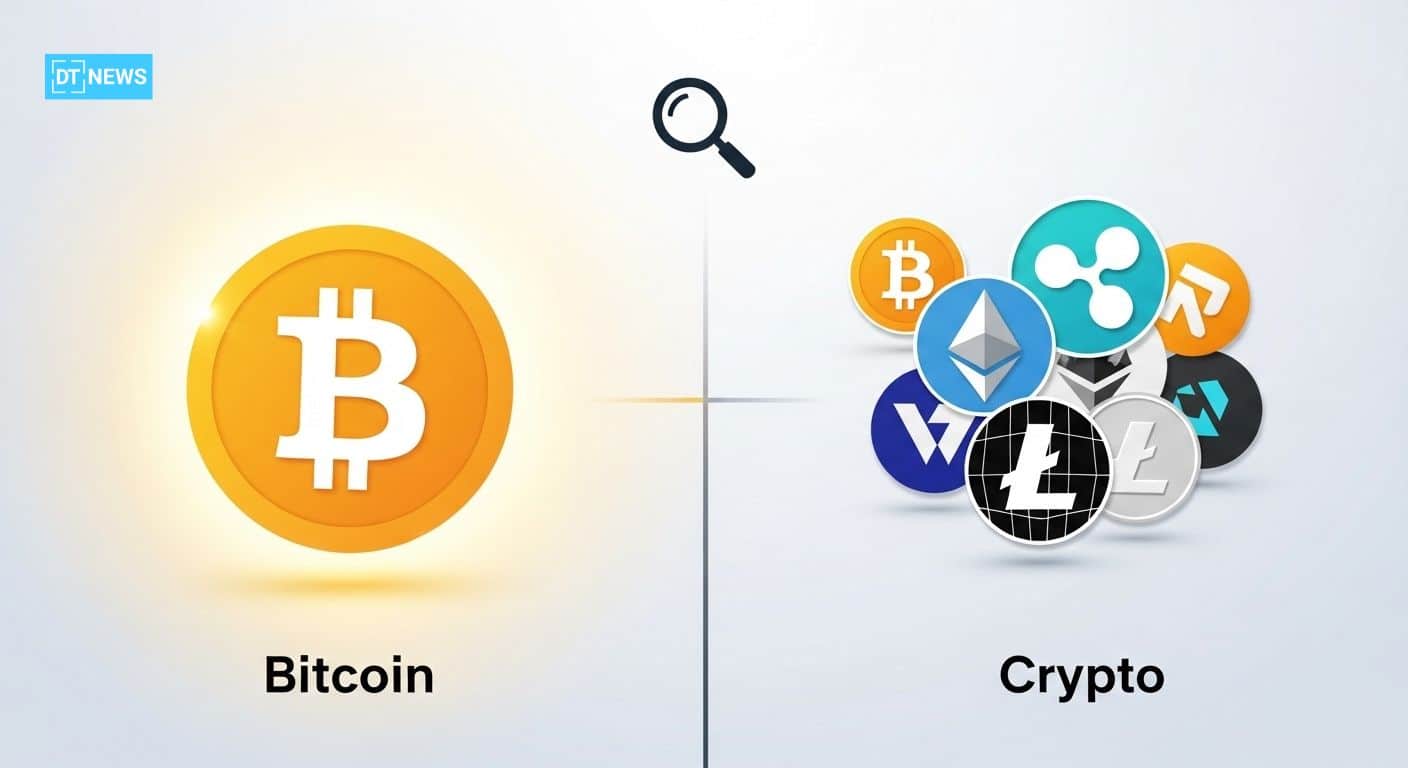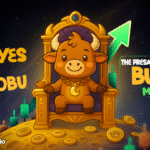Updated on 26th October, 2025
This article was first published on Deythere.
- What “Crypto” Really Means vs. Bitcoin’s Original Purpose
- Bitcoin’s Unique Design: A Digital Cash System
- Bitcoin vs. Other Crypto: Notable Differences
- Regulation, Policy and Bitcoin’s Unique Status
- Expert Insight: Why Bitcoin is Not Crypto
- Conclusion
- Glossary
- Frequently Asked Qustions About Jack Dorsey “Bitcoin is not crypto”
- What did Jack Dorsey mean by “Bitcoin is not crypto”?
- Is Bitcoin a cryptocurrency?
- How is Bitcoin different from other cryptocurrencies?
- Why is Bitcoin called “digital gold” or “digital cash”?
Just recently, Twitter and Block founder Jack Dorsey reignited an ongoing debate by tweeting out that “Bitcoin is not crypto”. His blunt claim opened up a long-standing view within the Bitcoin community.
Dorsey and others are saying that it is Bitcoin’s design, governance, and real-world use as money that sets it apart from the broader crypto market, not just some arbitrary make-up of its code.
His “Bitcoin is not crypto” tweet emphasized the view that Bitcoin’s role is fundamentally different. He had stressed for ages that Bitcoin was created as peer-to-peer digital cash, not just some other speculative token.
What “Crypto” Really Means vs. Bitcoin’s Original Purpose
The word crypto is a short form for cryptocurrency, a broad category of digital assets that rely on cryptography. All cryptocurrencies use cryptography and distributed ledgers.
Bitcoin’s creator, Satoshi Nakamoto, didn’t think of it as just another generic digital asset; he described it in his 2008 whitepaper as a “peer-to-peer electronic cash system”, a currency that can be sent without needing a bank in the middle.
In the first sentence of the whitepaper, he talks about “Bitcoin, peer-to-peer electronic cash…without a central intermediary”. And he never uses the word “crypto”, making it clear that Bitcoin’s original vision was purely monetary from the get-go.
Over time, crypto came to include tons of other projects. Platforms like Ethereum, stablecoins, tokens and smart-contract applications. As a result, some Bitcoin advocates view crypto as a label that often implies lots of speculation and many infinite-supply altcoins.
For many Bitcoin maximalists, the word “crypto” has taken on a sort of negative connotation. They see most crypto projects as speculative and inflationary, with virtually infinite supplies, which is really different from Bitcoin’s scarcity.
By saying “Bitcoin is not crypto,” Dorsey and like-minded supporters are saying: treat Bitcoin as distinct digital money, separate from that wider crypto bucket.
Bitcoin’s Unique Design: A Digital Cash System
Bitcoin’s internal design reinforces its intended role as money. Unlike a lot of newer coins, Bitcoin has no central issuer or development team that can change its rules whenever it wants.
There is “no issuer, no treasury, and no committee that can decide to dilute holders next quarter, as one analysis puts it.
Bitcoin’s supply cap of 21 million coins and issuance schedule are hard-coded into the software. Its security comes from proof-of-work mining, which requires real-world resources to add blocks in, making attacks costly and the system quite politically neutral.
These features create a predictable, unchangeable supply; a digital analogue to a really rare commodity like gold, which many people think is a hallmark of money, not just some other token.
On the other hand, most crypto tokens can be minted, destroyed, or governed by small groups of people. Their governance and supply often change through some kind of vote or token-holder ballot, not through immutable code.
Thus, experts say that this difference in control and who gets to decide how many gets issued is at the heart of why Bitcoin is not crypto.
As one analyst puts it, most of what the market calls crypto, relies on completely different rules for governance. Tokens often have teams in charge and admin keys, and their economics can be changed with a vote or patch.
“Those systems might be fine for some kind of experimental project or software platform,” the analyst argues, “but they just don’t look like something you can trust to hold onto with confidence for a decade”.
That fundamental difference Bitcoin’s fixed rules vs some others’ rules that can change on a whim, is exactly what Dorsey was pointing at.
Bitcoin vs. Other Crypto: Notable Differences
Bitcoin’s design and what it’s for can be looked at in comparison to other cryptocurrencies side by side. Below is a table highlighting some of the main differences:
| Feature | Bitcoin | Typical Crypto Tokens |
| Purpose | Digital money/store of value (peer-to-peer cash) | Many purposes: programmable platforms; DeFi, NFTs, utility tokens, etc. |
| Supply | Hard cap 21 million; fixed issuance schedule | Often inflationary; no fixed cap, or pre-mined reserves; supply can change by governance decision. |
| Governance | Fully decentralized; no central authority. Changes require consensus by miners and node operators. | Often managed by core teams or foundations; upgrades by voting or maintainers. |
| Security/Consensus | Proof-of-Work (energy-intensive mining) securing blocks with real-world cost. | Many use Proof-of-Stake or other mechanisms; some rely on smaller validator sets. |
| Issuance Control | Code-defined issuance; halving events reduce new supply. Immutable code. | Token economics can be altered (mint or burn tokens, change rules); via governance votes. |
| Regulatory Status | Treated often as a commodity/digital asset: e.g., the U.S. IRS classifies Bitcoin as property. | Many tokens are viewed as securities or utilities; classification varies widely (e.g. SEC review; MiCA rules). |
| Adoption / Use | Used as store of value (digital gold) and for settlement; on-chain scaling via Lightning Network. | Used in smart contracts, DeFi, on-chain games, and token ecosystems; often more volatile. |
| Investor Perception | Viewed as a long-term asset with limited supply. Labeled a currency in Bitcoin circles. | Often seen as speculative assets; many retail traders invest for quick gains. |
This comparison shows why lots of experts say Bitcoin is not like other crypto. Bitcoin’s very first whitepaper was about making a new kind of money. All of its rules support that goal: a capped supply and decentralized issuance.
Other digital currencies, also known as altcoins or tokens, are built for loads of different uses like software platform upgrades, decentralized apps. As experts note, Bitcoin’s design targets money, whereas most cryptocurrencies today are more focused on programmable applications.
Regulation, Policy and Bitcoin’s Unique Status
The way governments view Bitcoin is also something that sets it apart. In many places, Bitcoin is treated as an asset or commodity rather than a security.
For example, U.S. tax authorities consider Bitcoin to be property, so if there’s need to spend it, it gets hit with capital gains tax calculations; whereas other tokens may be classified as securities or crypto and are subject to entirely different rules.
Central banks, too, often talk about Bitcoin in a separate context. Many are skeptical about it being a currency or a payment system. Regulators have sometimes grouped Bitcoin in with all the other risks of the crypto sector.
For instance, after the 2022 market crashes, some new rules treated all tokens the same; lumping Bitcoin in with that picture of risk.
Jack Dorsey’s tweet can be seen as an attempt to change that way of thinking: he wants policymakers and the public to make up their minds about Bitcoin based on what it actually is, not based on how other tokens have done.
One real-world example of Bitcoin being on its own track is in financial products. Bitcoin has spawned loads of exchange-traded funds (ETFs) all around the world, allowing people to invest in Bitcoin as a separate asset class.
Many other cryptocurrencies have no ETFs at all, or are still fighting to be allowed to be included. As a result, some analysts say Bitcoin now sits on its own shelf compared to all the other tokens. Its fixed supply rules and growing acceptance in the institutional world (like ETFs) only go to prove that it is special.
Expert Insight: Why Bitcoin is Not Crypto
Experts have weighed in on this. David Schwartz, CTO of Ripple, addressed Dorsey’s wording directly. He said leaving out the article “a” was important.
Saying Bitcoin is not crypto doesn’t deny Bitcoin uses cryptography, but rather implies Bitcoin isn’t part of the speculative crypto bucket.
In modern usage, crypto often means alternative tokens, so Schwartz said Dorsey meant Bitcoin is separate from that class; not that Bitcoin itself isn’t a cryptocurrency in a technical sense.
In other words, Bitcoin uses cryptography.
Andreas M., Bitcoin Foundation advisor, has made similar points that Bitcoin was designed to be digital money, whereas many newer coins were just code experiments.
As an analyst put it, Bitcoin’s core features of fixed issuance, decentralized consensus, and proof-of-work security, remove discretionary control from any company or founder.
By contrast, tokens with visible teams or unchecked minting rely on trust in insiders.
Highlighting the practical side; calling Bitcoin “money” changes how it is treated for things like taxes, payments and risk. They point out that by putting Bitcoin in a separate money bucket, different rules apply like low fees and easier use in commerce.
Overall, the experts agree Bitcoin’s identity and economic model is unique. Its description has always been about value transfer and storage, not about powering apps or platforms. As one commentary says; Dorsey’s simple tweet is to let Bitcoin be judged on its own design; a design focused on trust, scarcity and neutrality.
Conclusion
In a nutshell, Bitcoin is not crypto because Bitcoin’s purpose and design are so different from the rest of the crypto space. Bitcoin was a peer-to-peer digital cash system with a fixed supply and immutable rules.
Unlike many crypto tokens issued by teams that can change on a vote, Bitcoin’s governance is fully decentralized and its money-like properties dominate its design.
As a result, Bitcoin is seen more as digital gold or currency, a separate asset class rather than just one of many crypto tokens. In short, Jack Dorsey’s tweet is saying: Bitcoin’s purpose, use, and regulation make it different from the speculative tokens that get lumped under “crypto.”
Glossary
Bitcoin: The first and most well-known cryptocurrency, created in 2009.
Cryptocurrency (Crypto): A type of digital asset; that uses cryptography and blockchain technology to secure transactions.
Blockchain: A distributed ledger that records transactions in blocks; chained together cryptographically. Bitcoin’s blockchain is the public record of all BTC transactions. Other blockchains (like Ethereum); host smart contracts and tokens.
Decentralization: A system design where no single entity has control. Bitcoin’s network is decentralized across many miners and nodes.
Bitcoin Maximalist: Someone who believes Bitcoin is the only true cryptocurrency and that other tokens are inferior or unnecessary.
Peer-to-Peer Electronic Cash System: The term used in Satoshi Nakamoto’s Bitcoin whitepaper to describe Bitcoin’s purpose. It means people can send money directly to each other over the internet; without banks.
Proof-of-Work: A consensus mechanism used by Bitcoin where miners compete; using computing power to add new blocks. It provides security through real-world resource expenditure.
Lightning Network: A second-layer payment protocol for Bitcoin that enables fast; low-fee transactions by creating off-chain payment channels. Often mentioned as a way to scale Bitcoin for everyday payments (in expert commentary).
Frequently Asked Qustions About Jack Dorsey “Bitcoin is not crypto”
What did Jack Dorsey mean by “Bitcoin is not crypto”?
He means Bitcoin should be seen as money with its own rules; not just another crypto. He and others argue that Bitcoin’s fixed supply, security model and use-case make it fundamentally different from the rest of the crypto market.
Is Bitcoin a cryptocurrency?
Technically yes; Bitcoin is a cryptocurrency (it’s a digital currency secured by cryptography). But in this context; advocates separate it conceptually. They say Bitcoin is “not crypto” meaning it’s not part of the usual token ecosystem and instead is digital money.
How is Bitcoin different from other cryptocurrencies?
Differences include Bitcoin’s fixed supply (21 million coins) and decentralized governance; versus many altcoins that have inflationary supply or centralized control. Bitcoin’s core purpose was peer-to-peer electronic cash, while many other coins focus on smart contracts, finance or apps.
Why is Bitcoin called “digital gold” or “digital cash”?
Because Bitcoin’s rules especially its limited supply; make it function like a scarce asset like gold and a form of electronic money. It was originally proposed as “peer-to-peer electronic cash”. Unlike volatile tokens, it’s often held for value and settling payments, which is why supporters emphasize that role over calling it just “crypto”.



















































































































